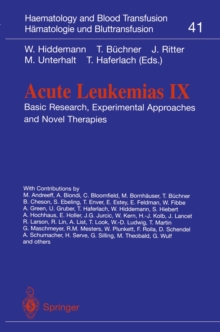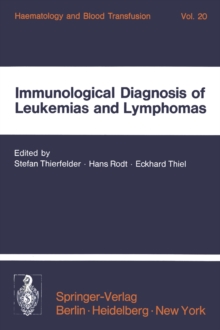
Acute Leukemias IV : Prognostic Factors and Treatment Strategies Paperback / softback
Edited by T. Buchner, W. Hiddemann, B. Wormann, G. Schellong, J. Ritter
Part of the Haematology and Blood Transfusion Hamatologie und Bluttransfusion series
Paperback / softback
Description
The rates of acute leukemia cure have gradually improved over the last decade.
Clinical study results reflect the impact of chemotherapy intensity and duration, the role of prolonged maintenance, intensified consolidation or very early intensification.
Further progress has also been achieved in bone marrow trans plantation, and recent prospective studies and meta-analyses have contributed comparisons of the high antileukemic efficacy of bone marrow transplantation to that of improved chemotherapy.
This allows a more successful combining of the two forms of treatment.
New prognostic factors have emerged from both cytogenetic and molecular genetic research.
Thus, the Philadelphia chromosome translocation and the bcr/abl gene rearrangement have proven to be the dominating risk factor in acute lymphoblastic leukemia.
Since the frequency increases with age, differences in prognosis between children and adults can be explained.
Evaluation of molecular and immunologic leukemia cell markers has provided a better understanding of residual leukemia in clinical remission, as a prognostic factor and in monitoring the effectiveness of the antileukemic strategy.
Recent work on leukemic cell biology has resulted in novel therapeutic approaches such as terminal differentiation by all-trans-retinoic acid, modulation of chemotherapy by hematopoietic growth factors such as GM-CSF and enhancement of immunologic control by cytokines such as interleukin 2.
New antimicrobial drugs and the application of mostly empiric anti-infectious strategies have helped reducing the therapeutic risk.
Thus, a number of recent achievements have provided us with new options in the management of patients with acute leukemias.
Information
-
Out of stock
- Format:Paperback / softback
- Pages:803 pages, XXXVI, 803 p.
- Publisher:Springer-Verlag Berlin and Heidelberg GmbH & Co. K
- Publication Date:05/12/2011
- Category:
- ISBN:9783642783524
Information
-
Out of stock
- Format:Paperback / softback
- Pages:803 pages, XXXVI, 803 p.
- Publisher:Springer-Verlag Berlin and Heidelberg GmbH & Co. K
- Publication Date:05/12/2011
- Category:
- ISBN:9783642783524










